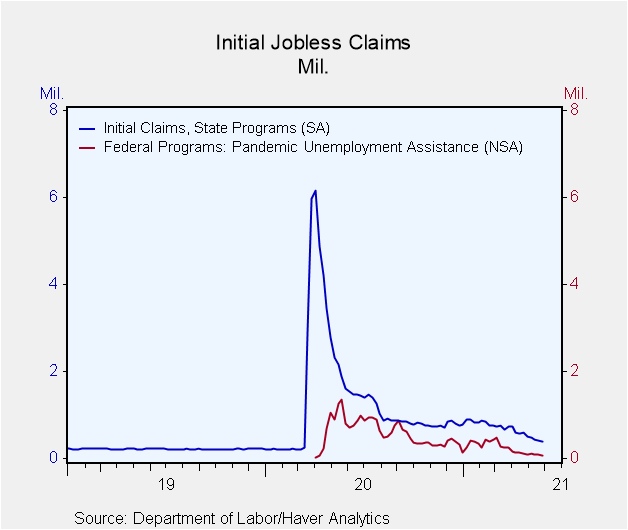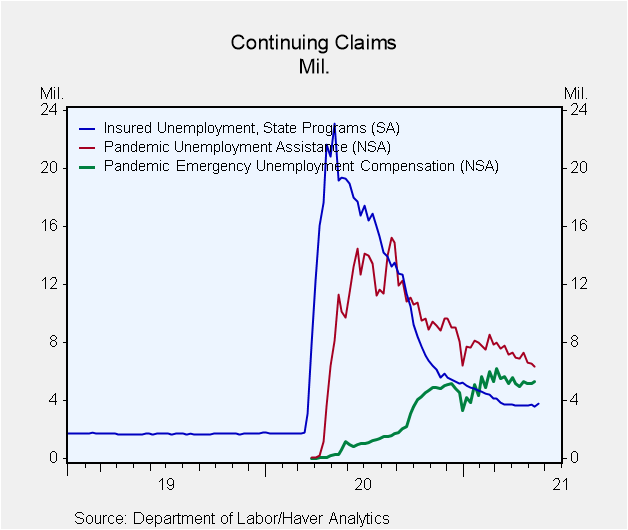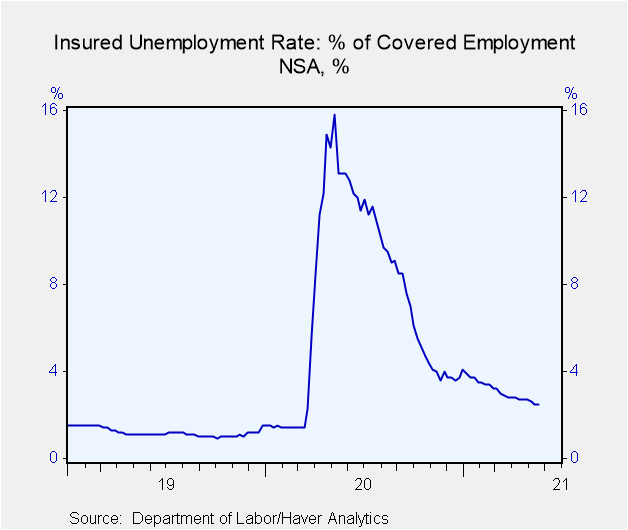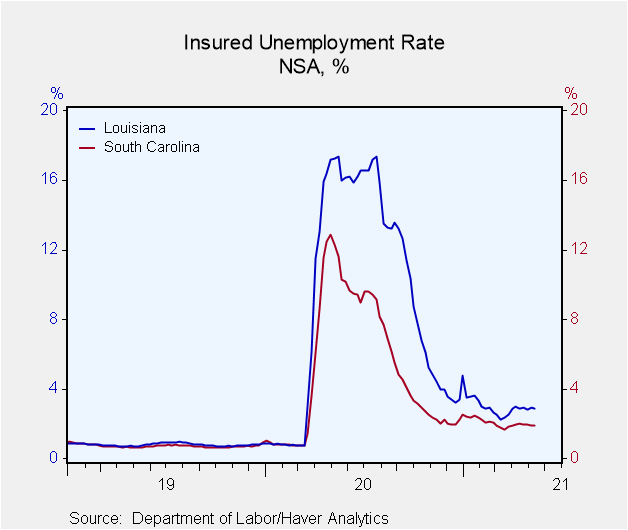 Global| Jun 03 2021
Global| Jun 03 2021U.S. Jobless Claims Extend Low Range
Summary
• Initial state claims down another 20,000. • Continuing state claims edge upward, but maintain recent pandemic low range. • PUA claims lowest since very first week of program in April 2020. Initial claims for unemployment insurance [...]
• Initial state claims down another 20,000.
• Continuing state claims edge upward, but maintain recent pandemic low range.
• PUA claims lowest since very first week of program in April 2020.
Initial claims for unemployment insurance fell 20,000 in the week ended May 29 to 385,000 from the prior week's 405,000, marginally revised from 406,000. The Action Economics Forecast Survey panel expected 400,000 new claims in the latest week. These regular state-program claims are now approaching the pre-pandemic "normal" of just over 200,000 that prevailed from early 2018 until the pandemic struck in March 2020. The latest week has lowest number since 256,000 in the week of March 14, 2020. The 4-week moving average was 428,000 in the latest week ended May 29, down from 458,500 in the previous week and also a pandemic low.
Initial claims for the federal Pandemic Unemployment Assistance (PUA) program fell to 76,098 in the week ended May 29 from 93,559 the previous week. The most recent figure is the lowest since April 4, 2020, the first week of the program, which saw 32,078 initial claims. The PUA program provides benefits to individuals, such as the self-employed, who are not eligible for regular state unemployment insurance benefits. Given the brief history of this program, these and other COVID-related series are not seasonally adjusted.
Continuing claims for regular state unemployment insurance rose slightly in the May 22 week, amounting to 3.771 million, up 169,000 from the week before. The resulting state insured rate of unemployment ticked back up to 2.7% from 2.6% in the May 15 week. The rate had a high of 15.9% in the week of May 9, 2020, while the average rate in 2018 and 2019 was 1.2%.
Continuing PUA claims were 6.368 million in the week ended May 15, down from 6.516 million the prior week. Continuing PEUC claims rose 102,000 in that week to 5.294. This program Pandemic Emergency Unemployment Compensation (PEUC), cover people who had already exhausted their state unemployment insurance benefits when the pandemic struck.
The total number of all state, federal, and PUA and PEUC continuing claims was 15.436 million in the May 15 week, down 366,178 from the previous week. This was the lowest reading since just after the pandemic-related programs began in early April 2020. This grand total is not seasonally adjusted.
The state insured rates of unemployment in regular programs continued to vary widely. In the week ending May 8, the highest insured unemployment rates were in Nevada (5.51%), Rhode Island (4.61%), Connecticut (4.31%), Alaska (4.15%), Pennsylvania (3.85%). The lowest rates were in South Dakota (0.61%), Oklahoma (0.63%), Kansas (0.75%), Nebraska (0.81%), and Alabama (0.84%). Insured unemployment rates in other large states included New York (3.76%), Illinois (3.57%), California (3.47%), Texas (1.80%) and Florida (1.59%). These state rates are not seasonally adjusted.
Data on weekly unemployment claims going back to 1967 are contained in Haver's WEEKLY database, and they are summarized monthly in USECON. Data for individual states are in REGIONW. The expectations figure is from the Action Economics Forecast Survey, carried in the AS1REPNA database.
| Unemployment Insurance (SA, 000s) | 05/29/21 | 05/22/21 | 05/15/21 | Y/Y % | 2020 | 2019 | 2018 |
|---|---|---|---|---|---|---|---|
| Initial Claims | 385 | 405 | 444 | -76.0 | 1,352 | 218 | 220 |
| Initial Claims (NSA) | 425 | 419 | 455 | -73.6 | 1,353 | 218 | 221 |
| Initial Claims Pandemic Unemployment Assistance (NSA) | 76 | 94 | 95 | -90.4 | -- | -- | -- |
| Continuing Claims | -- | 3,771 | 3,602 | -80.6 | 10,380 | 1,699 | 1,754 |
| Continuing Claims (NSA) | -- | 3,504 | 3,481 | -81.7 | 10,370 | 1,704 | 1,763 |
| Continuing Claims Pandemic Unemployment Assistance (NSA) | -- | -- | 6,368 | -- | -- | -- | -- |
| Insured Unemployment Rate (%) | -- | 2.7 | 2.6 |
13.9 |
7.1 | 1.2 | 1.2 |
Carol Stone, CBE
AuthorMore in Author Profile »Carol Stone, CBE came to Haver Analytics in 2003 following more than 35 years as a financial market economist at major Wall Street financial institutions, most especially Merrill Lynch and Nomura Securities. She has broad experience in analysis and forecasting of flow-of-funds accounts, the federal budget and Federal Reserve operations. At Nomura Securites, among other duties, she developed various indicator forecasting tools and edited a daily global publication produced in London and New York for readers in Tokyo. At Haver Analytics, Carol is a member of the Research Department, aiding database managers with research and documentation efforts, as well as posting commentary on select economic reports. In addition, she conducts Ways-of-the-World, a blog on economic issues for an Episcopal-Church-affiliated website, The Geranium Farm. During her career, Carol served as an officer of the Money Marketeers and the Downtown Economists Club. She has a PhD from NYU's Stern School of Business. She lives in Brooklyn, New York, and has a weekend home on Long Island.









